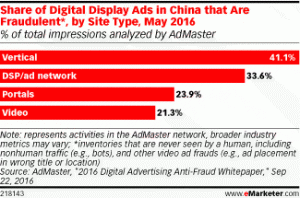The State of Ad Fraud in China
As we know, ad exchanges operate fully automatically. Due to the lack of human control, ad fraudsters are able to use non-human traffic activity for gaining profit. Ad fraud happens all over the world, yet in China the problem is particularly severe.

A report from RTBAsia, China’s leading anti-fraud tech company, tells that in 2015 “between 15% and 20% of China’s daily impressions traded on ad exchanges were from non-human bots registering impressions and clicking on ads.” The problem has gotten even worse in 2016. According to eMarketer research, at the $27 billion Chinese digital ad market, the fraud rate is up to 40%.
Ad fraud is regarded as a problem that cannot be controlled completely and has a bad influence on the advertising industry. Advertisers in tech agencies have their own complaints as to the situation. They believe some companies in China, claiming that they can solve the fraud problem, to be a scam.
The unique market and the Guanxi
Programmatic advertising in China lags several years behind western countries. Chinese programmatic ecosystem is still developing. The market is more fragmented and has unique Internet infrastructure. Thus, Facebook, Twitter, Google etc, which are popular in the rest of the world, are not used on the same level here.
Since the programmatic ecosystem is incomplete, the problem arises that there is no good third-party platform to help monitor the situation. There is also a lack of regulations for monitoring the problem.
Guanxi (literally – “relationship”) is an important notion in Chinese business culture. If an advertiser wants to get a deal, not only the focus on the positive solution is needed, but also building good relationships with publishers. Such relationships significantly strengthen publishers, while lowering the pressure of developing a mature market.
4 ways to fight Ad Fraud
1. All efforts to the industry
Advertising ecosystem is built on trust. In China, BAT (Baidu, Alibaba, Tencent) has more consumer data than the west, but they don’t share it. As the result, data cannot be translated to the industry at large. In order to solve this problem, the whole industry, including the advertisers, agencies and publishers, has the responsibility to improve integrity and promote transparency of advertising.
2. Cut out injected ads
In the past few years, a number of advertisers were warned by Facebook about fake ads. Some appliances and battery products use injected ads to get bigger ad conversion. On Feb 8, 2017, Facebook emailed a number of advertising agencies in China, announcing the ban of Chinese app ads. Injected ads appear where they aren’t supposed to and create bad user experience. That is why they need to be stopped.
Here is what needs to be done in terms of fighting ad fraud using the third party:
- Development of programmatic ecosystem and 3rd-party data management platform.
- Monitoring the traffic in real time to stop deceiving ads before they get clicked.
- Third-party platform must keep improving its monitoring skills and provide its customers with more effective data.
4. Select your partners wisely
The recent Methbot Scam case proves the point. In the situation, when small firms fell victims to the fraudsters’ scheme, Admixer hasn’t been shaken. Thus, the problem affects larger companies on a much smaller scale.
To sum up, things will improve if the leading Chinese Internet companies, such as Tencent and Alibaba, take measures against ad fraud. And organizations, like IAB and TAG, need to start taking actions on Chinese market just the way they respond on other markets.




